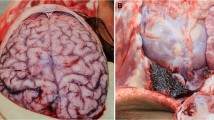Abstract
Vascular air embolism is caused by penetration of air into veins or arteries through a surgical wound or other connection between the external and internal aspects of the body. Vascular air embolism has various causes, and iatrogenic air embolisms are the most frequently described. We report a case of fatal air embolism in an 83-year-old woman who was admitted to hospital. At the time of the incident, she was alone in her ward receiving an intravenous infusion of antibiotics via a peripheral line in her right forearm. She was also inhaling air through a mask, which was connected via a tubing system to a compressed air connection in the wall behind her bed. Autopsy and postmortem computed tomography (PMCT) findings are presented. The case illustrates the high diagnostic value of PMCT, which is an effective procedure for detecting the presence of air or gas.








Similar content being viewed by others
References
Muth CM, Shank ES. Gas embolism. N Engl J Med. 2000;342:476–82.
Palmon SC, Moore LE, Lundberg J, Toung T. Venous air embolism: a review. J Clin Anesth. 1997;9:251–7.
McCarthy CJ, Bahravesh S, Naidu SG, Oklu R. Air embolism: diagnosis, clinical management and outcomes. Diagnostics. 2017;7:5.
Takahashi Y, Sano R, Yasuda A, Kuboya E, Takahashi K, Kubo R, et al. Postmortem computed tomography evaluation of fatal gas embolism due to connection of an intravenous cannula to an oxygen supply. Leg Med (Tokyo). 2017;27:1–4.
Szabo M, Engart G. Selbstmordversuch durch intravenöse Luftinjektion. Z Rechtsmed. 1971;68:38–40.
Bunai Y, Nagai A, Nakamura I, Kanno S, Yamada S, Ohya I. An unusual case of fatal gas embolism. Am J Forensic Med Pathol. 1999;20:256–60.
Makino Y, Shimofusa R, Hayakawa M, Yakjima D, Inokuchi G, Motomura A, et al. Massive gas embolism revealed by two consecutive postmortem computed-tomography examinations. Forensic Sci Int. 2013;231:e4–10.
Rouse DA, Hargrove R. An unusual case of gas embolism. Am J Forensic Med Pathol. 1991;13:268–70.
Acknowledgments
We thank Angela Morben, DVM, ELS, from Edanz Group (www.edanzediting.com/ac) for editing a draft of this manuscript.
Author information
Authors and Affiliations
Corresponding author
Ethics declarations
Conflict of interest
The authors declare that they have no conflict of interest.
Rights and permissions
About this article
Cite this article
Edler, C., Klein, A., Püschel, K. et al. Fatal air embolism in hospital confirmed by autopsy and postmortem computed tomography. Forensic Sci Med Pathol 14, 251–254 (2018). https://doi.org/10.1007/s12024-018-9961-2
Accepted:
Published:
Issue Date:
DOI: https://doi.org/10.1007/s12024-018-9961-2




